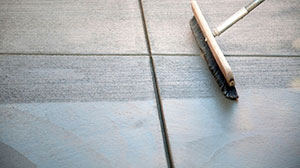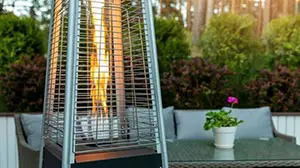
Patios are a frequented spot to gather and enjoy the company of others or to get some fresh air. Moving away from wood, it is becoming a more common feature for homes with a concrete patio, typically a builder-grade rectangular concrete slab.
To stain the concrete patio to look like stone, wash any dirt and grime surface, and remove any previous coatings. Select the desired stonework pattern and apply the stain to the surface.
After the paint dries, apply a sealant to preserve and protect the coat from fading away due to the outdoor environment.
Thankfully, with advances in technology, these standard and plain slab patios have the option to be easily customized and upgraded.
The wide range of staining options doesn’t just end at changing the color of the concrete but can also be used to make the concrete appear to be a more desired material, such as stone.
How to Stain Your Concrete Patio to Look Like Stone?
This illusion technique is a more cost-effective option for anyone wanting to renovate or freshen a patio. Here are the steps to get it done:
1. Prepare the Surface
To ensure the new stain can penetrate the surface and adhere long-term, properly preparing the patio is necessary. Preparing the surface includes washing away dirt and grime and removing any prior coats of paint or sealant.
Although paint is a noticeable coating, seeing if the concrete has a sealant layer is easy to conclude with only the naked eye.
One easy way to see if an existing sealant is present is to place drops of water on the surface. If the water absorbs into the surface, the surface doesn’t have an existing adhesive.
A sealant is present if the water rolls off the surface or sits on the concrete. Luckily, whether paint or glue exist, most concrete coating removal products sold at local home improvement and hardware stores can remove both.
The best process to remove previous coatings is to utilize a paint stripper explicitly manufactured for concrete surfaces.
Three types of paint strippers can remove layers from concrete surfaces:
- Caustic
- Solvent-based
- Biochemical
Each of these strippers has its niche of situations where they provide the best results.
Caustic Paint Strippers
This type of paint strippers excel in removing enamel and latex-based stains; however, they are not good at removing the basis of most sealants—polyurethane, acrylic, epoxy.
Solvent-Based Strippers
These are the most popular because they can quickly penetrate almost any type of coating, thick or thin. However, one downside to using solvent-based strippers, especially outdoors, is how quickly they can dry in direct sunlight or wind.
Biochemical Strippers
Last on the list is biochemical strippers, which are the best option when the project’s environment is sensitive. Suppose expensive landscaping or high-end grass, biochemical strippers, would best serve that situation.
However, these are the least aggressive form of paint strippers available and will take quite a while to penetrate the coatings and possibly multiple coats.
Solvent-based paint strippers are the most widely recommended for stripping concrete patios because they can penetrate thick layers of both paints and sealants rigorously.
Applying the Paint Stripper
Whichever type of paint stripper you choose, you can follow the following steps:
- Before applying the paint stripper, wash down the concrete patio to eliminate any layers of dirt and grime to allow the paint stripper to focus on really penetrating and breaking down the coats, rather than having to work through a layer of crud.
- Allow the surface to dry before application.
- Along with cleaning the surface, consider safety protocols before application. Since the product is hazardous, I recommend safety goggles, gloves, and closed-toed shoes.
- After gearing up in the proper attire, use the product by pouring it directly on the surface in a thick layer. If the product needs spreading, utilize a soft-bristled brush or broom or a squeegee. Let the stripper sit per the manufacturer’s instructions.
- Remember that solvent-based strippers dry quicker than other options available, so creating man-made shade via a tarp to block direct sunlight or placing plastic wrap along the surface will allow the solution to stay wet longer to penetrate the surface.
- After the recommended wait time, use a paint scraper or a putty knife to see if you can remove the desired layers of paint and sealant. If not, allow the solvent to sit longer if it is not dry. If it is dry, reapply another layer and repeat the process above.
- If the desired layers can be removed, scrape away the paint or sealants and pressure wash the excess debris.
2. Select a Stain
When it comes to selecting stain for the concrete, there are three types to choose from:
- Film-forming
- Acid
- Penetrating
Film-Forming Stain
Film-forming is the oldest form of concrete staining and performs by creating a pigmented film, or layer, over the surface of the concrete that can change the color and appearance of the concrete.
Patios receive high foot traffic and direct exposure to weather conditions. I do not recommend a film-forming stain from a durability standpoint. A film layer sits on the surface and will fade and chip away over time.
Acid Stain
Acid stain is a newer technology in the concrete staining world. While other stain options perform by simply applying pigment to the surface, acid stain relies on chemical reactions to etch the surface and alter the appearance of the concrete.
Acid stain consists of hydrochloric acid, water, and acid-soluble metallic salts. Concrete contains hydrated lime (calcium hydroxide).
When this hydrated lime comes into contact with hydrochloric acid, the chemical reaction causes etching on the surface.
This etching allows the metallic salts to penetrate deep into the surface and fill the pores of the concrete to change the overall appearance and color.
This stain usually leaves a marbling effect. The acid stain has excellent durability; however, it is wise to leave the application to professionals.
Acid stain is hard to control, and it is impossible to predict the turnout of the chemical reaction. It is not recommended for this to be the selected stain for an at-home project.
Penetrating Stain
Penetrating stain is the most popular form of concrete staining today. This form of stain has acrylic polymers and pigments, which will penetrate up to 4″ into the surface of the porous concrete when applied.
Penetrating stain provides an opaque appearance of deep coloring, highlighting natural variations. Penetrating stain is more durable than film-forming and is tamer than Acid staining.
I recommend a penetrating stain to make a concrete patio look like stone.
3. Select a Stencil Form
Making a slab of simple concrete resemble stone is a form of art. It is not as simple as painting the surface a different color.
Staining concrete to resemble stone takes a plain material. It manipulates stain hues and patterns to reach another natural, earthy material.
The next step is selecting a tool to apply the stone-like design. There are two main ways to stencil this surface:
- Stencil
- Tape
Stencil
There are plenty of stencils available to assist in painting concrete to look like stone. They come in various materials, including silicone, vinyl, and paper. Stencils have cutout patterns that block out the concrete parts that do not need to be stained.
The “stones” get penetrated with stain, while what would be “grout” in stonework would go unstained. This form of pattering is better for those who are not familiar with stonework, lack creativity, or do not want to take the time of taping out a design.
Tape
Taping is a technique that will allow for a custom design and a less uniform pattern. The first step is selecting a tape that will adhere to the concrete surface to seal off the concrete parts that do not need to be stained, aka the “grout” of the stonework.
Not all tape works for this process. The best tapes are industrial floor marking tape or rough surface masking tape. These are available online or in most home improvement or hardware stores.
Once you make an excellent tape selection, it is as simple as taping out the desired pattern and applying the stain.
The most common design pattern for stonework on patios is flagstone and bush rock.
4. Apply Your Stain
There are three ways to apply penetrating stain to concrete:
- Sponge
- Pump-type sprayer
- Paintbrush/roller
Sponge
Sponging concrete paint onto the surface is the most concise way to spread the color. Dip the sponge into the dye using a multipurpose sponge and eliminate any drippage.
Wipe the sponge within the broad areas of the stencil cutouts or taped-off areas, not wiping to the edges of each shape.
Once the center of these stenciled shapes have an even coat, dab with the tape or stenciled borders with the sponge.
The dabbing method along the edges will reduce seeping into the “grouted” areas and leave a more concise finish of each shape within the pattern.
Pump-type sprayer
Pump-type sprayers are plastic sprayers that have a handle connected to a stem coming out of the top of the base tank.
This manual pump holds the stain in the tank, and the handle is pressed and pumped to create pressure to spray the color.
Pour the stain into the tank and tighten the tank cap. Pump the tank handle as the tank manufacturer requires and spray the paint over the selected stencil in a sweeping motion to ensure an even coat.
Repeat until you achieve your desired coat. Spraying the stain onto the surface is the most time-efficient option.
Paintbrush or Roller
Paint brushing or rolling places second to sponging in terms of being concise and second to spraying regarding the amount of time spent on the staining process. If selecting a roller, use a ½” to ¾” thick napped roller made of polyethylene fibers or foam.
Use wide, flat nylon or polyester-based bristled paintbrush if using a brush. Dip the roller or brush into the stain, remove any excess, and apply the color over the broad area of the shape cutout in wide, even coats, avoiding the edges of the cutout.
Once the center of the shape is coated, use the roller or brush and apply from a bird-eye angle or perpendicular angle.
This applies the stain directly on top of the edges and reduces seeping into the “grout” area covered by the stencil or tape.
No matter which application technique is selected, be sure to remove any excess stain from the initial coating. Any areas with excess dye will appear darker and less uniform and increase the dry time.
If more than one coat is needed to get the desired stain shade, wait until the surface has dried to apply the second coat.
Remove all stencils and tape after the staining process is complete.
5. Seal the Surface
After designing and staining the concrete, applying a sealant is necessary to maintain and preserve the fruits of all that labor. A concrete sealant will protect the stain from UV rays, weather, and foot traction.
Although there are other options, you can apply concrete sealant efficiently and dependably by using a pump sprayer.
For sealant, building layers through multiple thin coats is better than one thick layer. I recommend applying at least two coats of sealant since the first coat will absorb into the concrete.
Let the sealant dry completely before applying another layer. Avoid foot traffic or rain/wetness until the sealant has completely dried.
Over time, reapplying the sealant may be required to ensure the strength of protection does not wear away.
Conclusion
There are options for almost every step in the process of staining a concrete patio to look like stone. Select each tool or method on time, labor, or desired finish.
No matter which path you take, be sure not to rush through any safety precautions, preparations, or aftercare.
Sources














